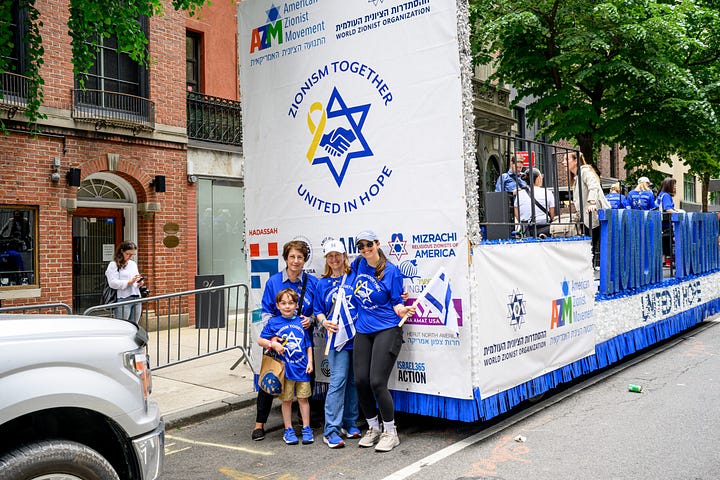The Jew News Review - July 11, 2025
From Topol to Glastonbury: How we went from cheering to jeering Jews
Shabbat shalom!


Let’s travel in the wayback machine to London, circa 1967. It’s just before the curtain rises on Fiddler on the Roof at a London theater, when Chaim Topol—Israel’s iconic Tevye—steps out before the audience. War had broken out back home. The Jewish state, surrounded by Arab armies vowing its destruction, was under existential threat. Topol announces he is leaving the production to join his fellow citizens in defense of Israel. The audience leaps to its feet in wild, thunderous applause. Not a slow clap of moral confusion. Not a begrudging acknowledgment that “it’s complicated.” No, this is real, heartfelt and sincere. They understand that this is a moment of moral clarity. The Jews had learned, finally, how to fight back.
Flash forward to June 2025’s Glastonbury Festival. Same island, different universe. Bob Vylan, a self-styled punk duo with more slogans than melodies, leads a crowd of well-fed, fashionably radical British festivalgoers in a chant: “Death to the IDF! Death to the IDF!” The crowd roars and chants along with them in approval—ecstatic, righteous, dripping with the performative adrenaline of a revolutionary LARP. It’s Woodstock for antisemites in bucket hats.
What the hell happened? As David Byrne of the Talking Heads once asked, “This is not my beautiful house…..How did we get here”?
It’s tempting to mark 1973’s Yom Kippur War as one of the inflection points in Israel’s historic fall from public grace . But while the trauma of that war certainly helped reshape Israeli politics internally, it didn’t flip the world’s moral compass just yet. Israel was still seen as a democracy fighting for its life. Sympathy remained strong, and U.S. support deepened. My generation was still happy to donate money to plant trees in Israel and help turn the desert green.
By the 1980s, anti-Zionism had found a cozy home on the left. Once the province of neo-Nazis and Soviet propagandists, it was now stylish among campus radicals and armchair revolutionaries. The Palestinian cause became a kind of moral coat rack—everyone could hang their politics on it. Marxists, Islamists, anarchists, even Christian pacifists. Palestine became a litmus test for leftist virtue. And Israel? It became a dirty word. Even worse, “Zionist” became a slur. The fact that nearly half the world’s Jews live in Israel? Minor detail. The fact that Zionism is the Jewish movement for national liberation? Too inconvenient.
But according to some historians, the real pivot came in 1982, when Israel invaded Lebanon in response to PLO attacks. What started as a defensive maneuver spiraled into a grinding war. Then came the Sabra and Shatila massacre, committed by Phalangist allies but blamed on Israeli complicity. The moral high ground—held tightly since the Holocaust—began to erode.
By 1987, the First Intifada made matters worse. Palestinian children throwing stones were televised daily, and suddenly Israel—the survivor state—was cast as the overarmed occupier. “Occupation” became the dominant narrative, amplified through Western media and the budding academic left.
By the time we hit the early 2000s, Israel was being accused of apartheid by people who couldn’t find the Negev Desert on a map. In 2001, the Durban Conference formalized the shift. What was supposed to be a UN anti-racism conference devolved into a Jew-hating echo chamber where “Zionism equals apartheid” became institutional orthodoxy. Then came BDS, social media, viral misinformation, and the seamless fusion of anti-Zionism with every woke buzzword from the DEI handbook.
Let’s not forget the summer of 2006. Israel was dragged into a war with Hezbollah—a genocidal, Iranian-backed terror group camped out in southern Lebanon and using civilians as shields. Western media coverage? A steady drumbeat of “both sides-ism” journalism, creating a moral equivalence between a sovereign democracy and a terrorist army whose stated goal is to eliminate that democracy. Dead Lebanese civilians were front-page news. Dead Israelis were usually buried on page ten—if mentioned at all. The BBC, now a bastion of Israel bashing, called it a “conflict” with “complex causes.” As if complexity is a substitute for judgment.
In 2014, during yet another round of Hamas-triggered violence, the shift in public discourse became fully digitized. Twitter, Facebook, Instagram—each became a firehose of misinformation, out-of-context photos, and viral lies. Images of Syrian casualties were passed off as “Israeli war crimes.” Protests erupted in cities from Paris to Toronto. Synagogues were vandalized. Jews beaten in the street. All because Israel dared to respond to rockets being launched from schoolyards and hospitals.
We reached the point where the existence of Jewish grief—real grief—was seen as a threat to the dominant narrative. In 2023, when Hamas carried out the most horrific massacre of Jews since the Holocaust, killing over 1,200 civilians in southern Israel, the sympathy window lasted about 48 hours. Then came the “context.” Then came the equivocation. Then came the “yes, but occupation.” As if babies burned in safe rooms somehow bore responsibility for geopolitics.
And now we have Glastonbury 2025. Bob Vylan, a duo of self-proclaimed “Black anarchists,” gleefully chanting for the death of Jewish soldiers—many of whom are barely old enough to drink. Many of whom are women, minorities, and refugees. The crowd? Cheering like it’s a soccer match. It’s a farce, but it’s also a funeral for the moral compass of the West.
The IDF—the army that sends texts and leaflets before strikes, that operates field hospitals for its enemies, that routinely risks its own soldiers to avoid civilian deaths—is branded the world’s evil. Meanwhile, terrorist groups that behead civilians and hide behind children are seen as “resistance.” This isn’t just moral confusion. It’s inversion. It’s perversion.
The Nut-and-Yahoo Factor
But you can’t trace the decline of Israel’s global image without stopping at Benjamin Netanyahu’s office door.
Just like our orange man, his name alone is enough to turn Thanksgiving tables into war zones. For his supporters, he’s the Churchill of the Middle East, a bulldog standing between Western civilization and theocratic obliteration. For his critics, he’s a right-wing populist who turned Israel from a moral cause into a partisan wedge—domestically divisive and internationally radioactive.
In 1967, Israel’s leaders were secular, socialist war heroes. Think Ariel Sharon and Moshe Dayan—men of gravelly voices and gravitas, not Twitter feeds and think tank talking points. They weren’t saints, but they spoke the language of sacrifice, shared burden, and national unity. Fast forward to the Bibi era—Netanyahu’s reign began in the late ’90s, then came roaring back in the 2000s, eventually metastasizing into the longest-serving prime ministership in Israeli history.
Under Bibi, the tone changed. He didn’t invent Israeli nationalism, but he branded it—with American-style fear-mongering, evangelical alliances, and Fox News finesse. He turned Israel into a partisan football in the U.S., aligning it closely with the Republican right and alienating generations of liberal American Jews in the process. He embraced far-right coalition partners, flirted with judicial dismantling, and governed through crisis as if crisis were the point.
To many in the West—especially young progressives raised on Occupy Wall Street and Black Lives Matter—Netanyahu became the face of Israeli militarism. They didn’t see a Holocaust survivor state trying to survive in a hostile region. They saw Bibi grinning at Trump in the White House, shaking hands with Viktor Orbán, and enabling settler violence in the West Bank. They saw Gaza airstrikes but ignored the rockets. They saw occupation, not terrorism. Netanyahu became a symbol—one that obscured far more than it revealed.
But here’s the problem: symbols are sticky. Once Netanyahu became the avatar of Israel abroad, everything Israel did—every justified strike, every real security need—was viewed through the lens of Bibi. If he did it, it must be cynical. If he supported it, it must be immoral. Even October 7—when Hamas butchered babies and livestreamed it—some corners of the left framed it as “blowback” to Netanyahu’s policies. As if 1,200 dead civilians were just a political reaction, not a genocidal ideology.
And yet—Netanyahu, the nationalist king, now finds himself loathed by many in his own country. After October 7, hundreds of thousands of Israelis protested his leadership. Veterans, reservists, centrists, even former Likud voters demanded accountability. It turns out that governing like a permanent campaign has consequences. You can’t tweet your way out of dead hostages and collapsed deterrence.
So when Bob Vylan took the stage in 2025 and led a crowd of thousands in a chant for the death of Israeli soldiers, it didn’t come from nowhere. It came after four decades of unspooling support, a media landscape addicted to binary heroes and villains, algorithms primed to promote pulling dead Palestinian babies out of rubble, the mainstream media propagandizing Hamas bullshit, years of Bibi’s arrogant leadership, and a generation taught that Israel is the final frontier of colonialism.
The IDF—an army that includes women, Muslims, Druze, Ethiopian Jews, and LGBTQ officers—is flattened into a caricature. Terrorist groups that literally behead civilians are hailed as “resistance.” The moral calculus is not just broken, it’s turned upside down and inside out. The more complex the truth becomes, the more aggressively the world seeks a simple lie.
But there is hope.
Despite the noise, a countercurrent is building.
Jewish students, long afraid to say the word “Zionist” out loud, are reclaiming it. Diaspora communities are waking up—not just to antisemitism on the right, but to its new, younger, trendier form on the left. They’re organizing, documenting, posting. They are saying: We are not your trope. We are not your villain. We will not disappear so you can feel morally pure.
Netanyahu, once the master of survival politics, now looks like a man out of time. And in that vacuum, something is stirring. A new generation of leaders—tired of the theatrics, hungry for unity—is emerging from the wreckage. If they succeed, they may do more than repair Israeli democracy. They may begin to restore its moral standing on the world stage.
And there are some silver linings: The same social media networks that spread lies can also spread truth. Survivors of the October 7 massacre have posted firsthand videos and testimonies that are beginning to break through the noise. Young Jews around the world—especially in the diaspora—are rediscovering their voice, their history, their identity. They are no longer content to blend into the progressive blob. They are saying, out loud and with pride: We are Zionists. Deal with it.
In places like Berlin, Paris, New York, and even London, Jews are organizing. Not to apologize. Not to explain. But to stand. And to sing. And to fight. Not with bombs or slogans, but with stories. With art. With memory. With a joy that infuriates the ideologues. They are returning to something ancient. Not just the right to self-defense, but the right to self-respect.
Topol went off to fight for Israel in 1967 and got a standing ovation. Today, a Jewish soldier does the same and gets doxxed on Instagram. But maybe the arc doesn’t just bend toward justice. Maybe it bends toward clarity—eventually. Maybe this new generation of Jews, forged in the fire of October 7 and the betrayal of Glastonbury and a thousand other Glastonburys, will find their way back to center stage. Not to beg for applause. But to demand a hearing.
And if you can’t give us that, we’ll still be here—like Tevye, fiddling on the roof of a world that’s always one pogrom away from collapse, but still managing to play something beautiful.
That’s all for the week. Have a great weekend everyone!
Brad out.






